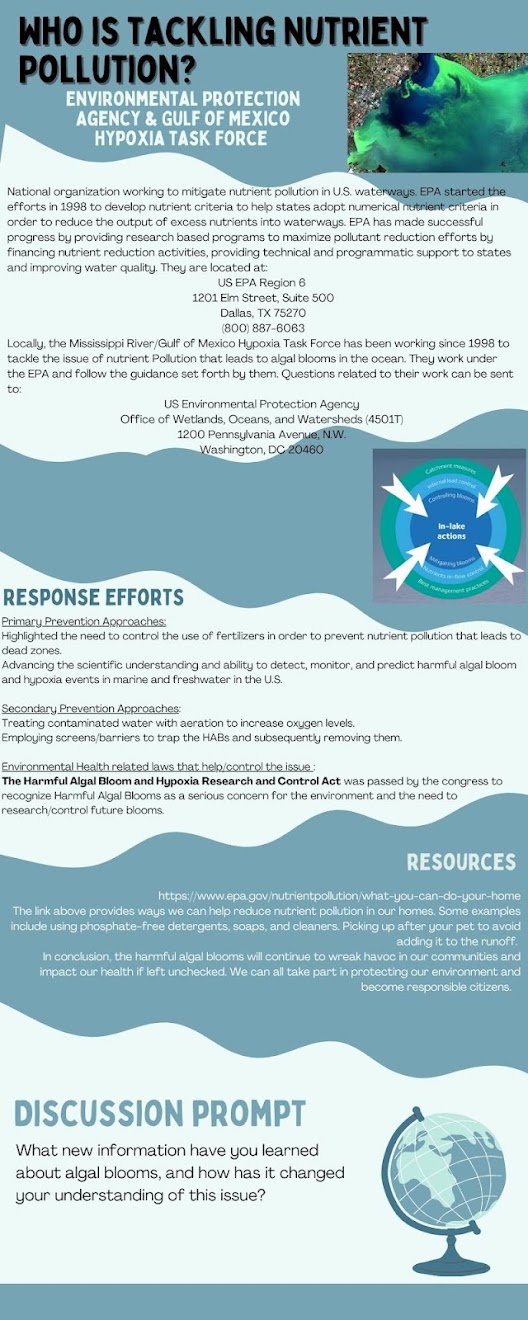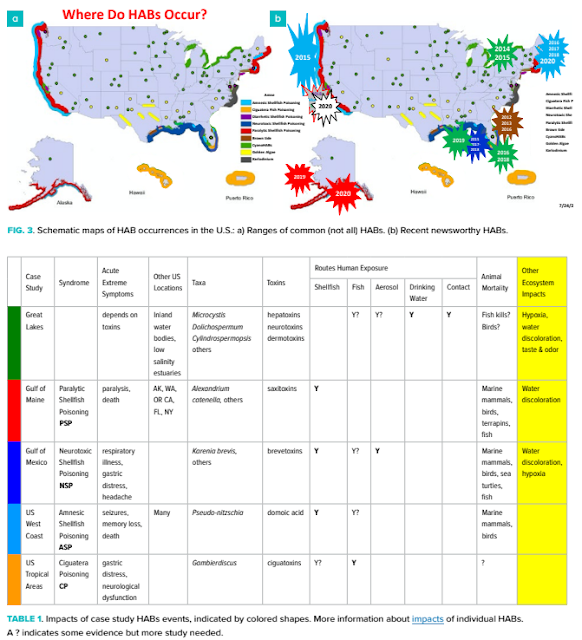Organizations Tackling Nutrient Pollution
On the national level, Harmful Algal Blooms (HABs) are being tackled by the Environmental Protection Agency (EPA). The EPA is researching and collecting data in response to The Harmful Algal Bloom and Hypoxia Research and Control Act passed in 1998. This law was passed after recognizing that further research was needed to understand the causes and impacts of algal blooms in water. EPA sought to monitor the sources causing HABs and reported the results to congress (United States Environmental Protection Agency, 1998). The law has been amended a few times but continues to help tackle this important environmental health issue. EPA collaborates with regional task forces and federal agencies such as United States Department of Agriculture to control the excess nutrients in waterways. They work to raise public awareness about HABs as well as conduct surveillance to collect data outlining health impacts. The One Health Harmful Algal Bloom System (OHHABS) is created by EPA to promote awareness of HABs as well collect nationwide human illness data.
Mississippi River/Gulf of Mexico Hypoxia Task Force (HTF) works specifically in the Gulf of Mexico region to tackle the issue of dead zones caused by algal blooms (Mississippi River/Gulf of Mexico Hypoxia Task Force, 2022). This task force works under the EPA and reports its findings/data to them. HTF coordinates activities to reduce the size, severity, and duration of the hypoxic zone as well as lessening the effects of hypoxia. In addition, HTF works to restore habitats, and coordinate/support nutrient management activities from all sources. Remember, nutrient pollution is the major cause of dead zones in the Gulf of Mexico resulting from the Mississippi river. The task force has outlined the sources of nutrient pollution and works directly with the U.S. Department of Agriculture (USDA) to regulate the amount of nutrient loading in agriculture. The efforts of the HTF have resulted in grants of $60 million from EPA to implement nutrient reduction strategies in the states that had the highest contribution of nutrient pollution for the Gulf of Mexico.
The infograph below can be used to educate people about the organizations tackling the issue of algal blooms. It provides the prevention approaches and laws that help/control this issue (Control Measures for Cyanobacterial HABs in Surface Water, 2022). Please share it to increase awareness that helps reduce nutrient pollution in our waterways.
References
2022 EPA Nutrient Reduction Memorandum. (2022, April 5). US EPA. Retrieved
August 7, 2022, from
https://www.epa.gov/nutrient-policy-data/2022-epa-nutrient-reduction-memorandum
Control Measures for Cyanobacterial HABs in Surface Water. (2022, April 26). US EPA.
Retrieved August 7, 2022, from
https://www.epa.gov/cyanohabs/control-measures-cyanobacterial-habs-surface-water
EPA’s Efforts to Reduce Nutrient Pollution. (2022, April 19). US EPA.
Retrieved August 7, 2022, from
https://www.epa.gov/nutrient-policy-data/epas-efforts-reduce-nutrient-pollution
The Harmful Algal Bloom and Hypoxia Research and Control
Amendments Act (HABHRCA).
(2022, April 26). US EPA. Retrieved August 7, 2022, from
https://www.epa.gov/cyanohabs/harmful-algal-bloom-and-hypoxia-research-and-control-amendments-act-habhrca
Mississippi River/Gulf of Mexico Hypoxia Task Force. (2022, June 28). US EPA. Retrieved
August 7, 2022, from https://www.epa.gov/ms-htf
United States Environmental Protection Agency. (1998, June).
National Strategy for the Development of Regional Nutrient Criteria.
Office of Water.


Hi,
ReplyDeleteWith these 2 task forces, what has been the success rate? It sounds like there is funding and federal support but I am interested in how their efforts have paid off. Great post. The inforgraph is a bit hard to read just because of the quality it uploaded in. I look forward to reading more regarding the Algal Blooms.
Hello Sophia, thank you for reading the blog post about the organizations tackling nutrient pollution. As you mentioned, there is federal support along with funding available. This is still an ongoing effort to provide incentives, and support all the states in reducing the output of nutrient pollution. It is hard to measure the success rate when there are multiple factors contributing to this issue. I'm sorry about the size of the infographic, it has been fixed now.
DeleteHello!
ReplyDeleteIts great to see national and local organization advocating for nutrient pollution. People often neglect this part of nature. Increasing the font on your infographic will allow for the information to be seen clearer. Overall great post
Hi Bre, I didn't realize the size of the infographic was so small, it was created in Canva. I hope you can see it better now.
Delete